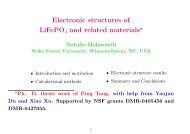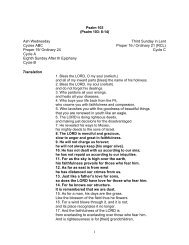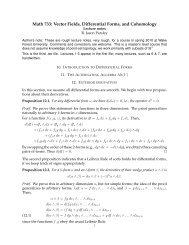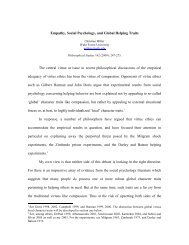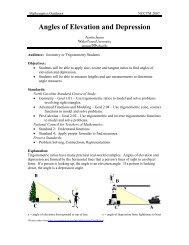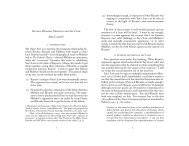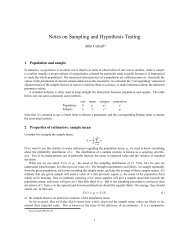However, when applied <strong>in</strong> a straightforward manner to large scale NNLS problems, thisalgorithm’s performance is found to be unacceptably slow ow<strong>in</strong>g to the need to perform theequivalent of a full pseudo-<strong>in</strong>verse calculation for each observation vector. More recently,Bro and de Jong [15] have made a substantial speed improvement to Lawson and Hanson’salgorithm for the case of a large number of observation vectors, by develop<strong>in</strong>g a modifiedNNLS algorithm.Fast NNLS fnnls :In the paper [15], Bro and de Jong give a modification of the standard algorithm forNNLS by Lawson and Hanson. Their algorithm, called Fast Nonnegative Least Squares,fnnls, is specifically designed for use <strong>in</strong> multiway decomposition methods for tensor arrayssuch as PARAFAC and N-mode PCA. (See the material on tensors given later <strong>in</strong> this paper.)They realized that large parts of the pseudo<strong>in</strong>verse could be computed once but usedrepeatedly. Specifically, their algorithm precomputes the cross-product matrices that appear<strong>in</strong> the normal equation formulation of the least squares solution. They also observed that,dur<strong>in</strong>g alternat<strong>in</strong>g least squares (ALS) procedures (to be discussed later), solutions tend tochange only slightly from iteration to iteration. In an extension to their NNLS algorithmthat they characterized as be<strong>in</strong>g for “advanced users”, they reta<strong>in</strong>ed <strong>in</strong>formation about theprevious iterations solution and were able to extract further performance improvements <strong>in</strong>ALS applications that employ NNLS. These <strong>in</strong>novations led to a substantial performanceimprovement when analyz<strong>in</strong>g large multivariate, multiway data sets.Algorithm fnnls :Input: A ∈ R m×n , b ∈ R mOutput: x ∗ ≥ 0 such that x ∗ = arg m<strong>in</strong> ‖Ax − b‖ 2 .Initialization: P = ∅, R = {1, 2, · · · , n}, x = 0, w = A T b − (A T A)xrepeat1. Proceed if R ≠ ∅ ∧ [max i∈R (w i ) > tolerance]2. j = arg max i∈R (w i )3. Include the <strong>in</strong>dex j <strong>in</strong> P and remove it from R4. s P = [(A T A) P ] −1 (A T b) P4.1. Proceed if m<strong>in</strong>(s P ) ≤ 04.2. α = − m<strong>in</strong> i∈P [x i /(x i − s i )]4.3. x := x + α(s − x)4.4. Update R and P4.5. s P = [(A T A) P ] −1 (A T b) P4.6. s R = 08
5. x = s6. w = A T (b − Ax)While Bro and de Jongs algorithm precomputes parts of the pseudo<strong>in</strong>verse, the algorithmstill requires work to complete the pseudo<strong>in</strong>verse calculation once for each vectorobservation. A recent variant of fnnls, called fast comb<strong>in</strong>atorial NNLS [4], appropriatelyrearranges calculations to achieve further speedups <strong>in</strong> the presence of multiple observationvectors b i , i = 1, 2 · · · l. This new method rigorously solves the constra<strong>in</strong>ed least squaresproblem while exact<strong>in</strong>g essentially no performance penalty as compared with Bro and Jong’salgorithm. The new algorithm employs comb<strong>in</strong>atorial reason<strong>in</strong>g to identify and group togetherall observations b i that share a common pseudo<strong>in</strong>verse at each stage <strong>in</strong> the NNLS iteration.The complete pseudo<strong>in</strong>verse is then computed just once per group and, subsequently,is applied <strong>in</strong>dividually to each observation <strong>in</strong> the group. As a result, the computationalburden is significantly reduced and the time required to perform ALS operations is likewisereduced. Essentially, if there is only one observation, this new algorithm is no different fromBro and Jong’s algorithm.In the paper [24], Dax concentrates on two problems that arise <strong>in</strong> the implementationof an active set method. One problem is the choice of a good start<strong>in</strong>g po<strong>in</strong>t. The secondproblem is how to move away from a “dead po<strong>in</strong>t”. The results of his experiments <strong>in</strong>dicatethat the use of Gauss-Seidel iterations to obta<strong>in</strong> a start<strong>in</strong>g po<strong>in</strong>t is likely to provide largega<strong>in</strong>s <strong>in</strong> efficiency. And also, dropp<strong>in</strong>g one constra<strong>in</strong>t at a time is advantageous to dropp<strong>in</strong>gseveral constra<strong>in</strong>ts at a time.However, all these active set methods still depend on the normal equations, render<strong>in</strong>gthem <strong>in</strong>feasible for ill-conditioned. In contrast to an active set method, iterative methods,for <strong>in</strong>stance gradient projection, enables one to <strong>in</strong>corporate multiple active constra<strong>in</strong>ts ateach iteration.3.2.2 Algorithms Based On Iterative MethodsThe ma<strong>in</strong> advantage of this class of algorithms is that by us<strong>in</strong>g <strong>in</strong>formation from a projectedgradient step along with a good guess of the active set, one can handle multiple activeconstra<strong>in</strong>ts per iteration. In contrast, the active-set method typically deals with only oneactive constra<strong>in</strong>t at each iteration. Some of the iterative methods are based on the solutionof the correspond<strong>in</strong>g LCP (8). In contrast to an active set approach, iterative methods likegradient projection enables the <strong>in</strong>corporation of multiple active constra<strong>in</strong>ts at each iteration.Projective Quasi-Newton NNLS (PQN-NNLS)In the paper [46], Kim, et al. proposed a projection method with non-diagonal gradientscal<strong>in</strong>g to solve the NNLS problem (6). In contrast to an active set approach, gradientprojection avoids the pre-computation of A T A and A T b, which is required for the use of9



